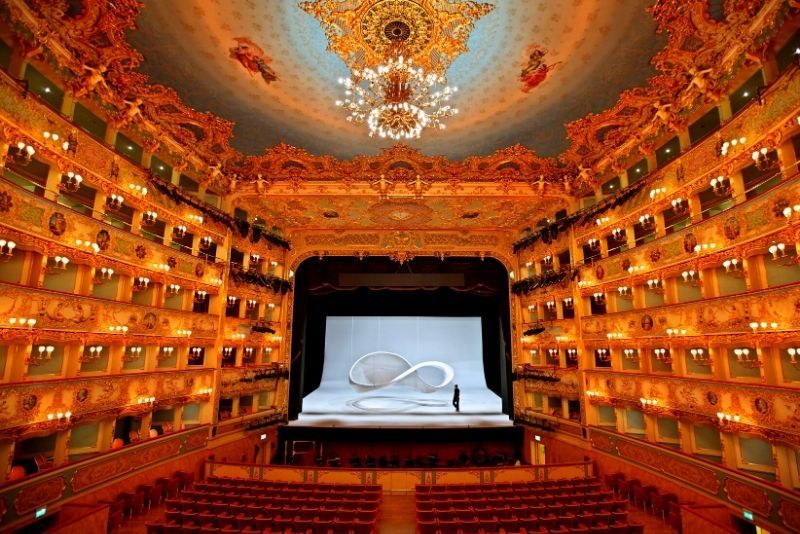La Fenice Theatre: Tickets and Tours
La Fenice Theatre represents the golden age of Italian opera and it’s been home to the premieres of works by Verdi, Rossini and Bellini. Today, visitors to Venice can explore this baroque masterpiece with La Fenice Theatre tours — providing unfettered access to this grand old building, while a qualified guide illuminates its hidden history and tales of splendor.
Imagine what the world must have been like when this opera house was the center of the musical universe — when Italian composers reigned supreme and the rich and famous thronged for seats to Verdi’s 'La Traviata'. Explore the theatre’s inner workings like the orchestra pit, the backstage area and the opulent balcony suits, arguably some of the grandest in all of Europe.
La Fenice Theatre represents the golden age of Italian opera and it’s been home to the premieres of works by Verdi, Rossini and Bellini. Today, visitors to Venice can explore this baroque masterpiece with La Fenice Theatre tours — providing unfettered access to this grand old building, while a qualified guide illuminates its hidden history and tales of splendor.
Imagine what the world must have been like when this opera house was the center of the musical universe — when Italian composers reigned supreme and the rich and famous thronged for seats to Verdi’s 'La Traviata'. Explore the theatre’s inner workings like the orchestra pit, the backstage area and the opulent balcony suits, arguably some of the grandest in all of Europe.

(0/24) checking Musement...
La Fenice Theatre represents the golden age of Italian opera and it’s been home to the premieres of works by Verdi, Rossini and Bellini. Today, visitors to Venice can explore this baroque masterpiece with La Fenice Theatre tours — providing unfettered access to this grand old building, while a qualified guide illuminates its hidden history and tales of splendor.
Imagine what the world must have been like when this opera house was the center of the musical universe — when Italian composers reigned supreme and the rich and famous thronged for seats to Verdi’s 'La Traviata'. Explore the theatre’s inner workings like the orchestra pit, the backstage area and the opulent balcony suits, arguably some of the grandest in all of Europe.

Continue reading our guide to find out more about La Fenice Theatre, one of the most emblematic attractions in Venice.
What are the prices of La Fenice Theatre tours?
Taking La Fenice Theatre’s richly adorned interior into account, you’ll find that tours are surprisingly inexpensive.
La Fenice Theatre tour prices
- Adults (aged 19 and over): €12.00
- Children (aged 7 to 18): €7.00
- Infants (aged 6 and below): free of charge
- Guided group tour: €160
La Fenice Theatre group tours are for a minimum of 12 people, with an additional €14.00 for every person joining — up to a maximum of 20 participants. The group of 12 cannot be assembled from smaller groups at the theatre and the tour will be conducted in English, French or Italian.
An entrance ticket to La Fenice Theatre includes an audio guide in 10 languages — English, German, French, Spanish, Portuguese, Russian, Chinese, Japanese, Italian and Italian sign language.
How do I skip the line at La Fenice Theatre?
There any skip-the-line tickets for La Fenice Theatre, which are particularly useful during peak tourist seasons — allowing holders to enter straight into the theatre without queuing. These tickets are also valid for 12 months from the date of purchase, allowing flexibility in case your travel plans change.
Who is eligible for discounts?
There are discounts available for elderly citizens and students, and to qualify an identification or student card will need to be presented. There are also discounted packages for families with children aged between 7 and 18 years old.
Discounted tour tickets
- Students (aged 18 to 26): €7.00
- Seniors (aged 65 and older): €9.00
Family package tour tickets
- Two adults and one child: €25.00
- Two adults and two children: €30.00
- Two adults and three children: €35.00
- Two adults and four children: €40.00
Should I book in advance?
Definitely. Booking tours to La Fenice Theatre will provide peace of mind during peak tourist seasons — which in Venice is virtually all year round.
You’ll also be able to choose the time of your visit and skip the queue upon arrival. Most importantly though, booking your tours in advance will protect you from tickets being sold out.
What are the most popular La Fenice Theatre tours?
There are a number of La Fenice Theatre tours available and visitors will be able to choose from self-guided, group and private in-house tours — with the latter being subject to availability.
Self-guided La Fenice Theatre tour with an audio guide
A self-guided tour of the La Fenice Theatre is one of the most cost-effective ways of exploring this magnificent monument to the arts. An audio guide is included in your ticket and it will take you through this grand old building — from the outer facade to the depths of the richly adorned interior.
You’ll relive the tales of famous composers fretting over premieres, share in the fortunes of immortal artists and experience the opulence of the royal box. And because you’re in control of the experience, you’ll get to skip areas that don’t interest you, or simply visit them at the end.
Guided small group tour of La Fenice Theatre
Small group tours are the best way to experience the rich history and décor of the La Fenice Theatre. Say goodbye to large groups of tourists, all clamoring for that perfect picture or not being able to take your time at the exhibits — this tour is limited to a maximum of nine participants, providing a much more personal experience.
Your passionate guide will help you explore every nook and cranny of La Fenice Theatre — while telling you more about the splendid composers and operas that have graced its halls. You’ll even learn why the theatre was named after the Phoenix and the ironic twist that this moniker had in store.
Guided in-house tour with La Fenice Theatre employee
You won't get any more up close and personal with La Fenice Theatre than with this tour by a theatre employee. Your guide will have much more in-depth knowledge of the theatre and its history because they work there day in and day out.
Aside from the building’s storied past, they’ll also shine a light on what it takes to operate a world-class theatre in this day and age — a fascinating experience for anyone who love the arts.
Private promenade through the La Fenice Theatre
This tour presents the best and most exclusive way of exploring the gilded halls of La Fenice Theatre. Apart from unrestricted access to every corner of the building, you’ll enjoy stories and tales only shared with those deemed to be “friends of the theatre.”
As a bonus, at the end of your extensive tour, you’ll retire to one of the Apollonian Halls to enjoy a traditional aperitif — a fitting way to cap off a tour of such a grand building.
What will you see there?

La Fenice Theatre is widely regarded as one of the most important landmarks in Italian theatre. It was initially built in 1755, but it was destroyed by a fire and rebuilt in 1792.
Unbelievably, the theatre succumbed to fire twice more — first in 1836 and lastly in 1996. However, each time the theatre was restored to its former glory, becoming an embodiment of its name — which is Italian for phoenix.
To say that the theatre’s interior is impressive would be an understatement — every conceivable inch is covered in gold-gilded decorations, intricate statues and stunningly detailed paintings.
The auditorium can accommodate over 1000 patrons, and the seats are lined with fire-resistant velvet — a small nod to the building’s infernal history. At the sides of the auditorium, you’ll find the breathtaking Appolonian Halls — five elegantly decorated rooms that are used for receptions, private concerts and soirees.
But don’t get fooled into thinking that this is the peak of opulence on offer in this baroque behemoth — that title goes to the immaculate royal box, a viewing fit for a king. Sit in the lap of luxury and imagine what it felt like to watch Verdi walk out on stage and bow to an enamored audience.
La Fenice Theatre is one of the best examples of baroque and neo-classical design — and it offers such an assault on the senses that more than one visit might be required to take it all in.
Where is La Fenice Theatre? located
La Fenice Theatre is located in southeast Venice, in the famous San Marco neighborhood — home to the spectacular Saint Mark’s Basilica. It’s half an hour’s walk from Saint Lucia Station and you’ll cross over the Ponti degli Scalzi and the Grand Canal respectively.
Alternatively, you could take a gondola ride to your destination and arrive in true Venetian style.
What are the opening times?
Because La Fenice is still a fully operating theatre, opening times might be influenced by shows. As a rule, the theatre is open every day of the week, from 9:30 AM to 6 PM. Over weekends you can expect the operating hours to be from 9:30 AM to 1:30 PM.
When is the best time to visit La Fenice Theatre?
La Fenice Theatre is at its busiest in the evening over weekends. The best days of the week to explore the theatre in relative peace and quiet are Mondays, Tuesdays and Fridays. The best time of day tends to be early in the morning or later in the afternoon, just before closing time.
Which other attractions can be visited in Venice?
Travel tips
- Opening times for La Fenice Theatre change from day to day and visitors should consider consulting the official theatre timetable when planning their trips.
- Tours of La Fenice Theatre do not include access to any of the productions that are on show.
- In-house tours are subject to the number of guides available and tend to sell out quickly — consider booking in advance.
- Remember to take supporting documentation like student cards to qualify for discounts.
- Photography inside the theatre is allowed, but it’s not allowed to take photos in formal dress or arrange a photoshoot.
- An ID card will serve as a deposit for an audio guide.

